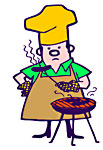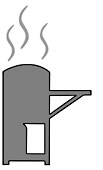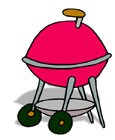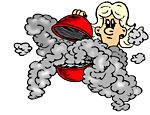|
|
The Barbecue: Summer Delight With A Sizzling Past
by Marjorie Dorfman
page 2
|
Smoking cuts of pork and beef with high heat using native oak and pecan has been common practice in Central Texas since its settlement by German and Czech immigrants in the mid 1800s. European settlers did not think of this meat as barbecue, and only began calling it that after hearing Anglo farm workers refer to it by that name. This type of barbecue is traditionally served without sauce and with no sides save saltine crackers, pickles and onions. Elgin hot links, derived directly from German influences, are often found in the Barbecue Belt southeast of Austin (not to be confused with the Bible Belt where nothing tastes nearly as good).
 Between the South Texas Plains and Northern Mexico, barbecue styles are as blurry as the borders and are mostly influenced by Mexican tastes. Using the less desirable cuts of meat such as the cow’s head and the diaphragm from which fajitas are made came from this birthplace of the Texas ranching tradition and the Mexican farmhands who were often paid for their work in this manner. Between the South Texas Plains and Northern Mexico, barbecue styles are as blurry as the borders and are mostly influenced by Mexican tastes. Using the less desirable cuts of meat such as the cow’s head and the diaphragm from which fajitas are made came from this birthplace of the Texas ranching tradition and the Mexican farmhands who were often paid for their work in this manner.
The farmhands would wrap the head in wet maguey leaves and bury it in a pit with hot coals for several hours. (This practice is risky but often a recommended welcome for bill collectors and nasty in-laws.) The meat would then be pulled off and used for tacos (barbacoa tacos) as was the tongue (lengua tacos). Today these barbacoa cuts of meat are usually prepared in an oven in a bain-marie.
The last style of Texas barbecue is derived from the ranching tradition as well, but developed in the western third of the state by Anglo ranchers. "Cowboy Barbecue" (which one might mistakenly assume comes from barbecuing a cowboy) actually involves cooking over an open pit using direct heat from mesquite. Meats utilized are usually beef with brisket and shoulder clods but mutton and goat are sometimes used as well.
In addition to variations throughout the US of A (as Archie Bunker used to say) there are almost as many throughout the world. Australia and New Zealand refer to throwing steaks on the Barbie. (Don’t worry. Our favorite doll and her boyfriend, Ken, are safe) and braai in South Africa refers to this same method of food preparation, which is utilized almost daily in that region. Food is cooked (usually meat) with the heat and hot gasses of a fire, smoking wood or hot coals of charcoal. The process may include the application of a marinade, spice rub or basting sauce added to the meat.
 Methods of cooking using more direct high-heat, namely grilling, have come to be associated with practitioners of barbecue. In grilling, a typical meal in some parts of the country means that the food is cooked on a grate directly over hot charcoal. A barbecued meal in that very same family however, usually means that the coals are dispersed either to the sides or at a significant distance from the grate. Methods of cooking using more direct high-heat, namely grilling, have come to be associated with practitioners of barbecue. In grilling, a typical meal in some parts of the country means that the food is cooked on a grate directly over hot charcoal. A barbecued meal in that very same family however, usually means that the coals are dispersed either to the sides or at a significant distance from the grate.
To further confuse matters, a smoker (an apparatus, not a person) with a separate firebox may also be used. With this method, hot smoke is drawn past the meat via convection at low temperatures for very slow cooking. Many restaurants prepare barbecues in this manner. Grilling over direct heat is quick and very hot (usually over 500 F) and is done over wood, charcoal or gas fires (and sometimes even the local police department). Arguments may ensue and be as heated as the meal in terms of calling a process barbecue smoking or grilling. (Just eat and enjoy it. Don’t worry about what to call it!)
Other factors that greatly influence barbecue flavor are the choice and combination of woods burned. Those most commonly selected include mesquite, hickory, maple, cherry, pecan, apple and oak. It is important to avoid conifers because they contain resins and tars and impart undesirable chemical flavors. (Of course if you enjoy roasting your socks in a luscious tomato-based marinade, you may want to give it a try!) If you want to use these woods, you should burn them in a catalytic grill, such as a rocket stove, so that the resins and tars are completely burned before coming in contact with the food.
Different types of wood burn at different rates and the heat also varies by the amount of wood and controlling the rate of burn through careful venting. Wood and charcoal are sometimes combined to optimize smoke flavor and consistent burning. Charcoal briquettes or lump charcoal, which unlike briquettes has not been ground and shaped, contains carbon monoxide, is highly combustible and cannot be burned indoors. After slow cooking in a smoker, meat can take on a pinkish color, which is caused by the carbon monoxide fumes.
 Many afficianados prefer propane gas to charcoal, which is more authentic in flavor (at least so some say). Still others extol the virtues of a charcoal chimney starter. This is an inexpensive and efficient method for getting a good charcoal fire. The fire can be ignited by a few sheets of newspaper wadded underneath the chimney, an electric iron, or lighting the fire in pyramid formation after charcoal is soaked with a petroleum solvent. The use of solvents is quick and portable, but it can be hazardous, and these can impart undesirable chemical flavors to the meat. Using denatured alcohol (methyl hydrate, methylated spirit) instead of commercial petroleum-based lighter fluids avoids this problem. Many afficianados prefer propane gas to charcoal, which is more authentic in flavor (at least so some say). Still others extol the virtues of a charcoal chimney starter. This is an inexpensive and efficient method for getting a good charcoal fire. The fire can be ignited by a few sheets of newspaper wadded underneath the chimney, an electric iron, or lighting the fire in pyramid formation after charcoal is soaked with a petroleum solvent. The use of solvents is quick and portable, but it can be hazardous, and these can impart undesirable chemical flavors to the meat. Using denatured alcohol (methyl hydrate, methylated spirit) instead of commercial petroleum-based lighter fluids avoids this problem.
The advantage with gas grills is that both lighting and heating are easy to control. Knob-controlled valves on burners make them safe and consistent. Some insist that a lack of true flavor occurs with this method while others claim that gas cooking lets you "taste the meat, not the heat." Also, many grills are equipped with thermometers, simplifying everything. Gas grills are more expensive and are considered much cleaner as they do not result in ashes that have to be disposed of. Proper maintenance can help to reduce that carbon footprint that is always lurking everywhere. A grill can also have a long life by obtaining replacement grill parts when the original wears out.
So whether you prefer to gas grill, propane, lump charcoal, briquette or whatever, the barbecue experience is a formidable one, full of mystery and flavor. Wherever it came from, it doesn’t really matter.
What’s that I smell on the grill outside? Excuse me, gotta run and…. eat some barbecue before there’s nothing left!

|
|
|
|
 |
|
|
Don't miss this excellent book:
The Cook's Illustrated Guide To Grilling And Barbecue:
A Practical Guide for the Outdoor Cook
by Cook's Illustrated

This book is a comprehensive nuts and bolts volume that thoroughly examines outdoor cooking starting with the basics. The 12-page introduction to grilling, "Outdoor Cooking 101," walks you step-by-step through the essentials of grilling, grill-roasting, and barbecuing using both charcoal and gas grills. Whether you’re a novice outdoor cook or aspiring grillmaster, this encyclopedic examination of one of America’s favorite pastimes will be your guide to foolproof grilling and barbecuing.
|

Click for a printer friendly version of this article.
|
|